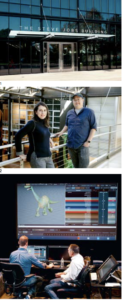Monocle, January 2016
A slice of fairytale magic could be yours for €50,000 for a 30-second commercial or a cool €200m for a blockbuster – but where is the heart of animation in 2016? From paintbrushes to computer screens, we profile a superpower and the pretenders waiting in the wings.
Intro:
There’s a cartoon – sorry, animation – doing the rounds that features all those Disney icons from our infancy. But instead of the hand-drawn imagery of yesteryear, these characters have been brought crashing into the 21st century. The reason? Computer Generated Imagery (CGI).
Some say the prevalence of computer-drawn digital imagery is stripping the industry of individual creativity. But animation-studio giants such as Pixar are proving that technology can be harnessed to create the most detailed animation we’ve ever seen (it doesn’t have to look like a computer game if you don’t cut corners). And small studios from Japan to the UK are also finding an audience.
Spanning films, advertising and music videos, this is a world of attention to detail where drawing, painting and moulding still exist. We’ve visited the large and the small to find out what’s shaping up for 2016. The future of animation may not be so much about the techniques but the ability to tell a funny, clever or moving story; achieve that and you’re on your way to winning over the audience.
Pixar, Emeryville
Wander around Pixar’s campus in Emeryville, northern California – yes, this is a “campus” – and you could be forgiven for thinking you were in Silicon Valley. Near the giant outdoor artwork of the company logo – a desk lamp – young employees flow in and out of the glass-doored Steve Jobs Building (the Apple man was one of the original founders). Nearby a vocal lunchtime game of basketball is taking place, while the more disciplined are doing lengths in a swimming pool that is neatly divided into lanes.
When it comes to animation, Pixar’s opuses trip off the tongue. The studio has been making a name for itself ever since its debut feature, Toy Story, in 1995; skip forward to the present day and the list of household-name films has swelled to Finding Nemo, Wall-E and many more.
Pixar is undoubtedly pioneering – and it’s set to continue in that vein. With its glimmering complex and membership of the Disney mega-family since 2006, it’s hard to imagine what it was like pre-Toy Story. “We had been on a shoestring budget for so long,” says lighting and photography director Sharon Calahan. “I had a third-hand desk that was falling apart and my chair didn’t have arms on it because they had broken off. Now we have a lovely campus and free cereal!”
While CGI has replaced hand-drawn movies, Pixar is stepping it up a gear and seeing how far it can push technology to remain at the forefront of animation. The stats for The Good Dinosaur, released in the US at the end of November 2015, are revealing. More than 900 effects shots in the film – a typically Pixar tale of a dinosaur who acts like a boy and a boy who behaves more like a dog – included work from by far the largest effects team on a Pixar film. “We’re all perfectionists,” says effects supervisor Jon Reisch, whose wife also works at Pixar. “You spend years on a film and we’re looking at really detailed minor points.”
While the animation business undoubtedly requires individuals with an obsessive personality and an ability to lock themselves in dark rooms for long periods of time, Pixar takes it to a whole new level. The effects team constantly has to pore over minute details, from creating a realistic CGI wine-pour action in Ratatouille to making sure the rapids and crashing waves of an angry river look realistic in The Good Dinosaur.
But it is the scenery in The Good Dinosaur that gives the clearest indication of where Pixar is heading in 2016. Modelled on parts of Montana, Idaho, Wyoming and Utah, the team downloaded 167,000 sq km of US geographical data and created a virtual set. They then zoomed through the area on a computer – CGI film scouts – and decided where they wanted to put their virtual camera. It was the first time such a detailed endeavour had been attempted.
With about 400 staff members contributing to any one film, which can take several years to complete, the number of departments and stages the film has to go through is overwhelming. And yet despite the protocols in place, Pixar president Jim Morris argues that the studio is old-school in many ways. “People here are staff as opposed to the majority of the motion-picture business where you go from project to project at different studios,” he says. “So we’re almost like an MGM of the 1930s or 1940s.”
Pixar seems to instil fierce loyalty and a desire to stay put but the studio isn’t resting on its laurels. It’s starting to slowly shift the emphasis away from founding directors such as John Lasseter to a younger generation that includes first-time director Peter Sohn. “I know it sounds trite,” he says with an earnest expression, ”but there are a lot of people here who love making movies.”
Although with each of those people producing as little as five seconds of animation per week, it certainly seems like a tough kind of love.
